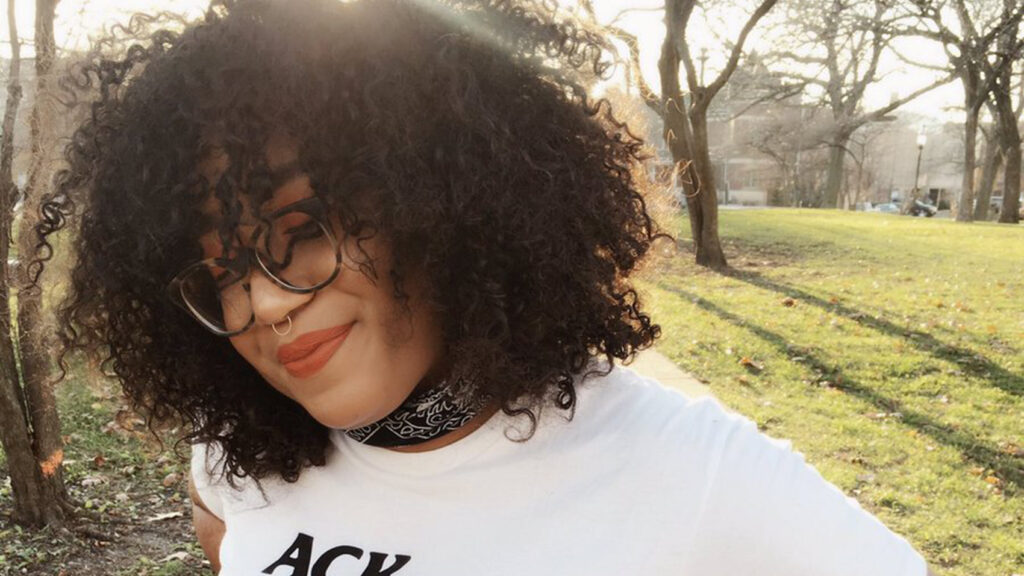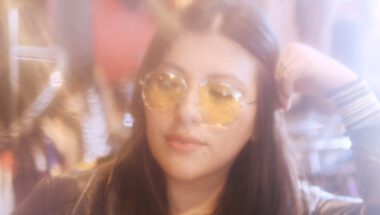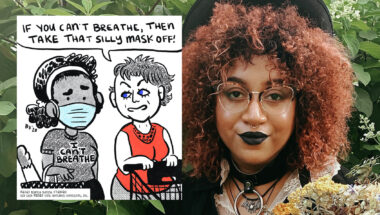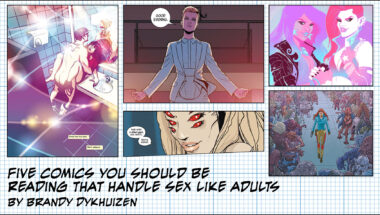When she was a kid, illustrator Bianca Xunise longed for a picket-fence life. Raised by her working class artist mother in the south suburbs of Chicago, she didn’t have the same kind of stability as her classmates, whose parents had more traditional jobs. She’s now grateful for her childhood crash course in the artist life, having grown up surrounded by her mother’s drawings and fashion designs, spending weekends dancing to new wave records and watching art house films.
Comics, she tells Riot Fest, were “always kind of a language that I spoke. Even in high school, when we would pass notes disobediently, mine would always be doodles.”
“I would draw all my friend’s crushes for them,” she laughs. “I was super into anime, and would tape dot matrix paper to the TV and trace Sailor Moon.”
The women in Xunise’s artwork, on the other hand, are anything but passive. They’re emotive — they sigh, sulk, and swoon over 80s hunks. The characters prance, pose, and flop on the floor with a “poot” sound effect bubbling out of their butt. They’ll drape themselves in black mesh, don a romantic goth beret, and get ready to face the world.
At times, they’re rightfully angry, speaking out against the injustices of racism, sexism and police brutality. Xunise herself often appears in illustrated form. At just thirty years old, she recently won the Ignatz Award for Promising New Talent with her comic “Say Her Name,” the autobiographical story of a terrifying encounter with the Chicago Police Department. Here’s a sample:
For our interview, Xunise asks me to meet her at Late Bar, a tiny Avondale dance club that regularly blasts Siouxsie and the Banshees til 4am. While she’s secure in her identity as a goth comics artist these days, she wasn’t always that way.
As a teenager, she believed that black women were excluded from white-dominated punk and goth subcultures (even as she spent her pocket money at Hot Topic and sewed her own elaborate Gothic Lolita outfits). On a similar note, even though she grew up drawing her experiences, she didn’t see her own life reflected in the graphic novels that received wide audiences and critical acclaim.
 While she was in college for graphic design, a colleague first introduced her to the artistic world that existed beyond the muscle-strapped superheroics of cape comics, or the male-dominated world of independent cartoonists like R. Crumb. However it wasn’t until she discovered the work of another young Chicago artist, Lucy Knisley, when Xunise realized that comics about the everyday lives of young women were in fact viable and in demand. It was then that she began publishing slice-of-life mini comics on her now-dormant fashion blog, Avant Blargh, where her illustrated doppelgänger tried on illustrated outfits and struggled to survive on your typical college student’s lack-of-a-budget.
While she was in college for graphic design, a colleague first introduced her to the artistic world that existed beyond the muscle-strapped superheroics of cape comics, or the male-dominated world of independent cartoonists like R. Crumb. However it wasn’t until she discovered the work of another young Chicago artist, Lucy Knisley, when Xunise realized that comics about the everyday lives of young women were in fact viable and in demand. It was then that she began publishing slice-of-life mini comics on her now-dormant fashion blog, Avant Blargh, where her illustrated doppelgänger tried on illustrated outfits and struggled to survive on your typical college student’s lack-of-a-budget.
She created Avant Blargh to document her menswear-inspired personal style and found success, even attending New York Fashion Week and parlaying the growing attention into her first commissions. “When I would do little advertising gigs for different companies, I’d slip in: ‘I’ll do this fashion look for Steve Madden, but you also have to let me do an illustration for Steve Madden.'”
Over time, she began prioritizing comics over fashion blogging. She was sick of endlessly documenting her outings, scrutinizing her looks, and dealing with the sizeism of the fashion industry and criticism of online strangers. “I feel like I missed my early-to-mid-twenties because I was spending so much time presenting it for other people’s consumption. I don’t doubt my sense of style, but I lost the passion for it completely.”
Despite her disillusionment with the fashion industrial complex, her work (published in media outlets such as The Nib, HelloGiggles, and Nylon magazine) still favors the authentically feminine. Characters suffer tragic and adorable cosmetic disasters, experiment with outfits, and “giggle and fart about boys.” The anticipation and romance of lust is idealized in a soft, squeaky-clean, rose-colored Tiger Beat-style light that reflects her public and performative crushes; attentions she focuses on her idol Keanu Reeves, as well as fictional monsters like vampires and The Chicago Mothman.
“In this world of Harvey Weinsteins and Trumps, and predatory men who are controlling it,” she says, explaining her lust for Chicago’s favorite cryptozoological creature, “there’s this allure of liking this fictional perfect male being. Nobody can come to me and say, ‘You know what the Mothman said about black women?’ — because he doesn’t exist.”
 While sexism and racism exists within any community, she’s heartened by the sense of camaraderie she feels attending Neo New Wave Thursdays at Debonair Social Club, or making her way into the pit to see one of her favorite punk bands at Riot Fest. “I feel like there were more people of color in the first few rows and in the main mosh pit [for The Misfits] than there were for Solange’s performance at Pitchfork this past year. When I was seeing Solange, I was in a crowd of white people. When I saw the Misfits, I was in a crowd of black and brown people.
While sexism and racism exists within any community, she’s heartened by the sense of camaraderie she feels attending Neo New Wave Thursdays at Debonair Social Club, or making her way into the pit to see one of her favorite punk bands at Riot Fest. “I feel like there were more people of color in the first few rows and in the main mosh pit [for The Misfits] than there were for Solange’s performance at Pitchfork this past year. When I was seeing Solange, I was in a crowd of white people. When I saw the Misfits, I was in a crowd of black and brown people.
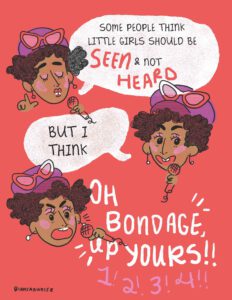 “One of the reasons I love the goth and punk communities,” she explains, “is that they’re some of the first places that I’ve been able to step into where the first thing registered about me isn’t that I’m a black person. They see me as one of their own. That’s so satisfying and so comforting, and one of the reasons why I defend these communities. They’re safe spaces where any person can feel like they fit in — no matter their race, gender, or body.”
“One of the reasons I love the goth and punk communities,” she explains, “is that they’re some of the first places that I’ve been able to step into where the first thing registered about me isn’t that I’m a black person. They see me as one of their own. That’s so satisfying and so comforting, and one of the reasons why I defend these communities. They’re safe spaces where any person can feel like they fit in — no matter their race, gender, or body.”
With her bright and bubbly cartooning style that encapsulates issues from the mundane to the life-shaking, Xunise has managed to find a place for herself in the goth scene, in the punk scene, and in the comics scene. The freedom of expression she’s found within those communities has allowed for making her voice heard. Better yet, she’s not the only one who’s been able to find the space to be herself there.
“There are black kids, there are Latinx kids, there are Asian kids, there are drag queens. There are trans femmes, trans men, queer kids, club kids, goth kids, and punk kids all coming together over this shitty Duran Duran song. It’s a beautiful thing to witness.“
